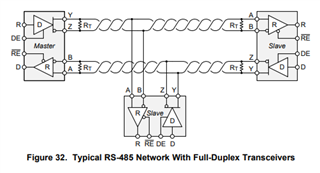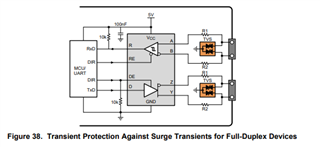Other Parts Discussed in Thread: THVD1451
Hello,
We are using the following chip THVD1452DGSR to build an RS485 full duplex network,
when we connect 3 units in the same bus following your technical information, we detect that the line to transmit the information from Slaves to the MASTER don't work as expected...the other line that the Master uses to send the information to the Slaves works fine... we are testing the following system:

We only get the system working if we disable all the Slaves transmission line (using the DE) and put one Slave at a time sending the information to the Master.
if we able all the Slaves transmisstion line, the system don't work... it looks like that teh voltage levels on transmission line decrease for low values, that are not recognized...
waiting for your help!
regards,
Hélder Cunha


